|
Size: 7501
Comment:
|
Size: 14786
Comment:
|
| Deletions are marked like this. | Additions are marked like this. |
| Line 8: | Line 8: |
| by Marshall Hampton. When the two frequencies are well seperated, we hear the right hand side of the identity. When they start getting close, we hear the higher-pitched factor in the left-hand side modulated by the lower-pitched envelope. {{{ |
by Marshall Hampton. When the two frequencies are well separated, we hear the right hand side of the identity. When they start getting close, we hear the higher-pitched factor in the left-hand side modulated by the lower-pitched envelope. {{{#!sagecell |
| Line 28: | Line 28: |
| def sinsound(freq_ratio = slider(0,1,1/144,1/12)): | def sinsound(freq_ratio = slider(1/144,1,1/144,1/12)): |
| Line 41: | Line 41: |
| html('<embed src="https:./test'+ lab +'.wav" width="200" height="100"></embed>') | html('<embed src="cell://test'+ lab +'.wav" width="200" height="100"></embed>') |
| Line 46: | Line 46: |
| == Karplus-Strong algorithm for plucked and percussive sound generation == by Marshall Hampton {{{#!sagecell import wave class SoundFile: def __init__(self, signal,lab=''): self.file = wave.open('./test' + lab + '.wav', 'wb') self.signal = signal self.sr = 44100 def write(self): self.file.setparams((1, 2, self.sr, 44100*4, 'NONE', 'noncompressed')) self.file.writeframes(self.signal) self.file.close() mypi = float(pi) from math import sin def ks(delay,length,blend = 0,filler=None,stretch=0): if filler == None: filler = [randint(-16383,16383) for q in range(delay+1)] outsig = filler[:] index = len(filler) while len(outsig) < length: s = random() if s > stretch: b = random() if b < 1-blend: newvalue = (outsig[index-delay]+outsig[index-delay-1])*.5 else: newvalue = -(outsig[index-delay]+outsig[index-delay-1])*.5 else: newvalue = outsig[index-delay] outsig.append(newvalue) index += 1 return [int(round(x)) for x in outsig] @interact def sinsound(delay = slider([int(2^i) for i in range(2,10)], default=100, label="initial delay"), blend=slider(srange(0,1,.01,include_endpoint=True),default=0,label="blend factor"), stretch=slider(srange(0,1,.01,include_endpoint=True),default=0,label="stretch factor")): s2f = ks(delay,int(44100*(1/2)),blend=blend,stretch=stretch) for i in range(12): s2f = s2f + ks(int(2^((12+i)/12.0)*delay),int(44100*(1/2)),blend=blend, stretch=stretch) html("Karplus-Strong algorithm with blending and delay stretching") html("<br>K. Karplus and A. Strong, <em>Digital synthesis of plucked string and drum timbres</em>, \nComputer Music Journal 7 (2) (1983), 43–55.<br>") html("Initial waveform:") show(list_plot(s2f[0:2000],plotjoined=True), figsize = [7,3.5]) html("Waveform after stabilization:") show(list_plot(s2f[20000:22000],plotjoined=True), figsize = [7,3.5]) s2str = ''.join(wave.struct.pack('h',x) for x in s2f) lab="" f = SoundFile(s2str,lab=lab) f.write() html('<embed src="cell://test'+ lab +'.wav" width="200" height="100"></embed>') }}} {{attachment:KarplusStrong.png}} |
|
| Line 49: | Line 107: |
| {{{ | {{{#!sagecell |
| Line 105: | Line 163: |
| {{{ | {{{#!sagecell |
| Line 119: | Line 177: |
| {{{ | {{{#!sagecell |
| Line 126: | Line 184: |
| print "<html>" # trick to avoid word wrap | |
| Line 128: | Line 185: |
| cProfile.run(cmd) | cProfile.runctx(cmd,globals(), locals()) |
| Line 130: | Line 187: |
| profile.run(cmd) print "</html>" |
profile.runctx(cmd,globals(), locals()) |
| Line 139: | Line 195: |
| {{{ | {{{#!sagecell |
| Line 150: | Line 206: |
| {{{ | {{{#!sagecell |
| Line 196: | Line 252: |
| by Pablo Angulo {{{ %cython |
by Pablo Angulo, Eviatar Bach {{{#!sagecell |
| Line 201: | Line 256: |
def cellular(rule, int N): |
from random import randint def cellular(rule, N, initial='Single-cell'): |
| Line 207: | Line 263: |
| initial: starting condition; can be either single-cell or a random binary row | |
| Line 208: | Line 265: |
| cdef int j,k,l M=zeros( (N,2*N+1), dtype=int) M[0,N]=1 |
M=zeros( (N,2*N+2), dtype=int) if initial=='Single-cell': M[0,N]=1 else: M[0]=[randint(0,1) for a in range(0,2*N+2)] |
| Line 213: | Line 272: |
| for k in range(N-j,N+j+1): | for k in range(0,2*N): |
| Line 216: | Line 275: |
| return M }}} {{{ |
return M[:,:-1] |
| Line 226: | Line 284: |
| def _( N=input_box(label='Number of iterations',default=100), | def _( initial=selector(['Single-cell', 'Random'], label='Starting condition'), N=input_box(label='Number of iterations',default=100), |
| Line 228: | Line 286: |
| size = slider(1, 11, step_size=1, default=6 ) ): | size = slider(1, 11, label= 'Size', step_size=1, default=6 ), auto_update=False): |
| Line 230: | Line 288: |
| M = cellular(rule, N) plot_M = matrix_plot(M) |
M = cellular(rule, N, initial) plot_M = matrix_plot(M, cmap='binary') |
| Line 234: | Line 292: |
| {{attachment:cellular.png}} | {{attachment:cellular2.png}} == Another Interactive Venn Diagram == by Jane Long (adapted from http://wiki.sagemath.org/interact/misc) This interact models a problem in which a certain number of people are surveyed to see if they participate in three different activities (running, biking, and swimming). Users can indicate the numbers of people in each category, from 0 to 100. Returns a graphic of a labeled Venn diagram with the number of people in each region. Returns an explanatory error message if user input is inconsistent. {{{#!sagecell # Adapted from http://wiki.sagemath.org/interact/misc # An_Interactive_Venn_Diagram # This interact models problems in which a certain number of people are surveyed to see if they participate in three different activities (running, biking, and swimming). Users can indicate the numbers of people, from 0 to 100. Returns a graphic of a labeled Venn diagram with the number of people in each region. Returns an explanatory error message if user input is inconsistent. @interact def _(T=slider([0..100],default=100,label='People surveyed'),X=slider([0..100],default=28,label='Run'), Y=slider([0..100],default=33,label='Bike'), Z=slider([0..100],default=59,label='Swim'),XY=slider([0..100],default=16,label='Run and Bike'),XZ=slider([0..100],default=13,label='Run and Swim'),YZ=slider([0..100],default=12,label='Bike and Swim'),XYZ=slider([0..100],default=7,label='Run, Bike, and Swim')): centers = [(cos(n*2*pi/3), sin(n*2*pi/3)) for n in [0,1,2]] scale = 1.7 clr = ['yellow', 'blue', 'green'] G = Graphics() for i in range(3): G += circle(centers[i], scale, rgbcolor=clr[i], fill=True, alpha=0.3) for i in range(3): G += circle(centers[i], scale, rgbcolor='black') # Label sets G += text('Run',(3,0),rgbcolor='black') G += text('Bike',(-1,3),rgbcolor='black') G += text('Swim',(-1,-3),rgbcolor='black') # Plot pairs of intersections ZX=XZ-XYZ G += text(ZX, (1.3*cos(2*2*pi/3 + pi/3), 1.3*sin(2*2*pi/3 + pi/3)), rgbcolor='black') YX=XY-XYZ G += text(YX, (1.3*cos(0*2*pi/3 + pi/3), 1.3*sin(0*2*pi/3 + pi/3)), rgbcolor='black') ZY=YZ-XYZ G += text(ZY, (1.3*cos(1*2*pi/3 + pi/3), 1.3*sin(1*2*pi/3 + pi/3)), rgbcolor='black') # Plot what is in one but neither other XX=X-ZX-YX-XYZ G += text(XX, (1.5*centers[0][0],1.7*centers[0][1]), rgbcolor='black') YY=Y-ZY-YX-XYZ G += text(YY, (1.5*centers[1][0],1.7*centers[1][1]), rgbcolor='black') ZZ=Z-ZY-ZX-XYZ G += text(ZZ, (1.5*centers[2][0],1.7*centers[2][1]), rgbcolor='black') # Plot intersection of all three G += text(XYZ, (0,0), rgbcolor='black') # Indicate number not in X, in Y, or in Z C=T-XX-YY-ZZ-ZX-ZY-YX-XYZ G += text(C,(3,-3),rgbcolor='black') # Check reasonableness before displaying result if XYZ>XY or XYZ>XZ or XYZ>YZ or XY>X or XY>Y or XZ>X or XZ>Z or YZ>Y or YZ>Z or C<0: print 'This situation is impossible!' if XYZ > XY: print 'The number of people who run, bike, and swim cannot be greater than the number of people who run and bike! (Why?)' if XYZ > XZ: print 'The number of people who run, bike, and swim cannot be greater than the number of people who run and swim! (Why?)' if XYZ > YZ: print 'The number of people who run, bike, and swim cannot be greater than the number of people who bike and swim! (Why?)' if XY > X: print 'The number of people who run and bike cannot be greater than the number of people who run! (Why?)' if XY > Y: print 'The number of people who run and bike cannot be greater than the number of people who bike! (Why?)' if XZ > X: print 'The number of people who run and swim cannot be greater than the number of people who run! (Why?)' if XZ > Z: print 'The number of people who run and swim cannot be greater than the number of people who swim! (Why?)' if YZ > Y: print 'The number of people who bike and swim cannot be greater than the number of people who bike! (Why?)' if YZ > Z: print 'The number of people who bike and swim cannot be greater than the number of people who swim! (Why?)' if C<0: print 'You have indicated too many people! The number of people exceeds the number of people surveyed. (Why?)' else: G.show(aspect_ratio=1, axes=False) }}} |
Sage Interactions - Miscellaneous
goto interact main page
Contents
Hearing a trigonometric identity
by Marshall Hampton. When the two frequencies are well separated, we hear the right hand side of the identity. When they start getting close, we hear the higher-pitched factor in the left-hand side modulated by the lower-pitched envelope.
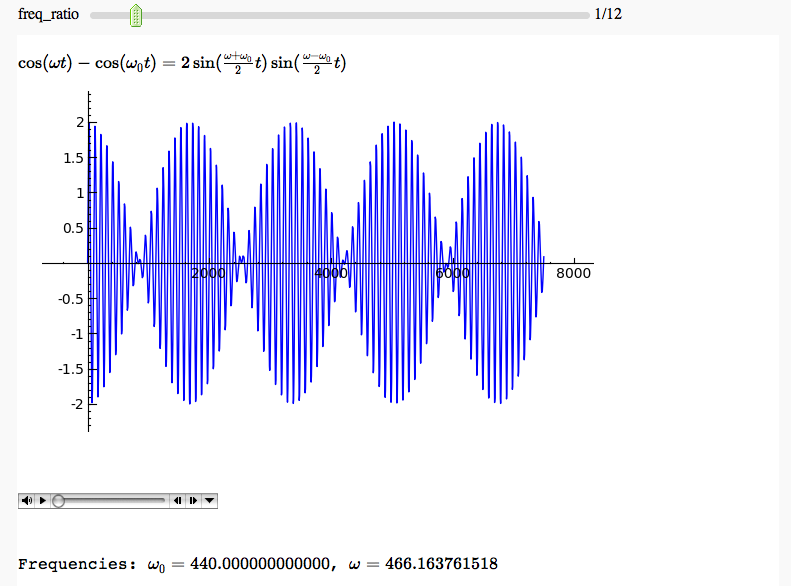
Karplus-Strong algorithm for plucked and percussive sound generation
by Marshall Hampton
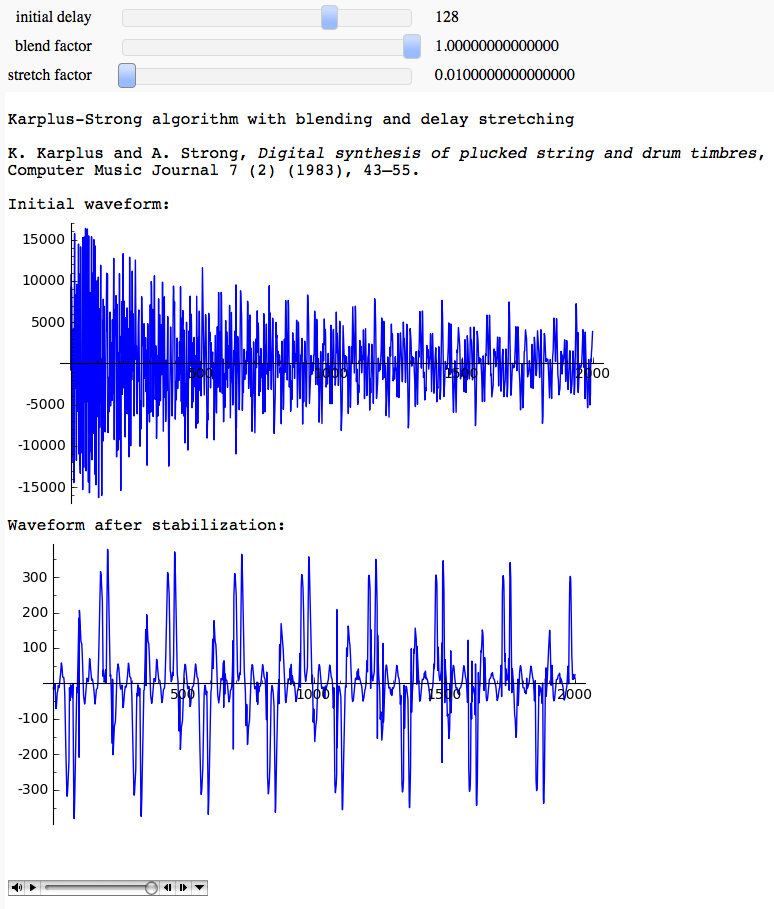
An Interactive Venn Diagram
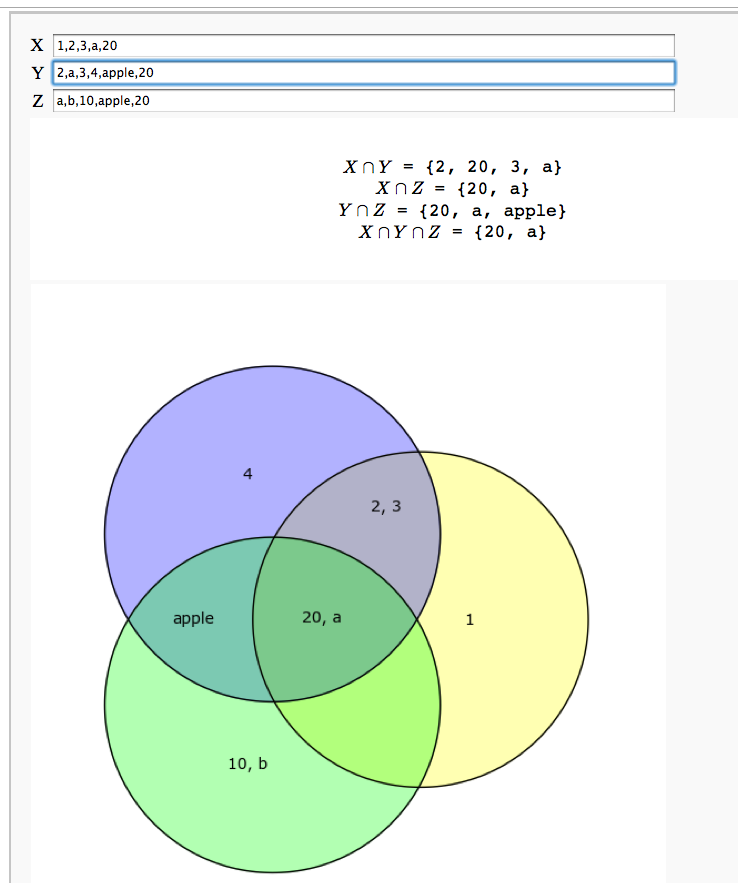
Unreadable code
by Igor Tolkov
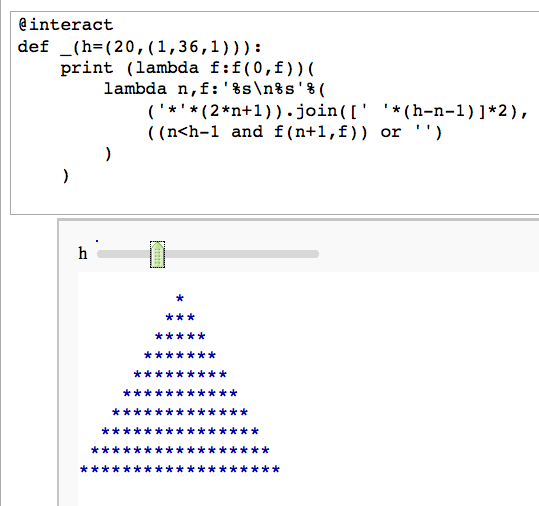
Profile a snippet of code
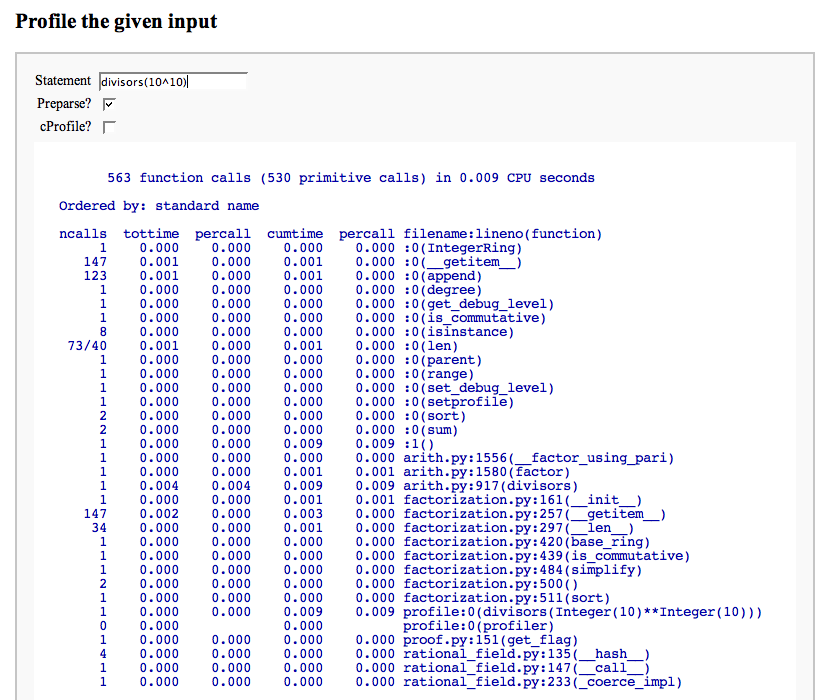
Evaluate a bit of code in a given system
by William Stein (there is no way yet to make the text box big):
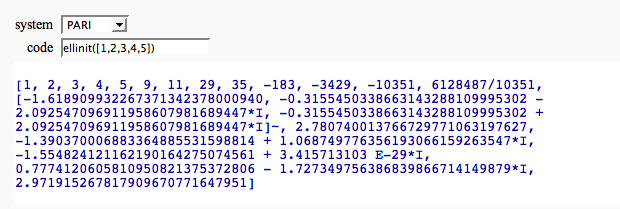
Minkowski Sum
by Marshall Hampton
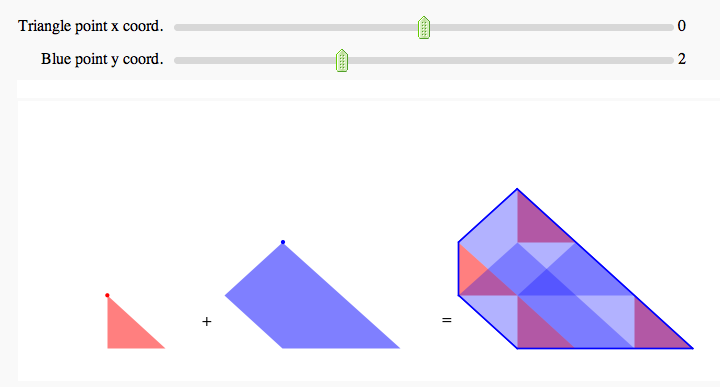
Cellular Automata
by Pablo Angulo, Eviatar Bach
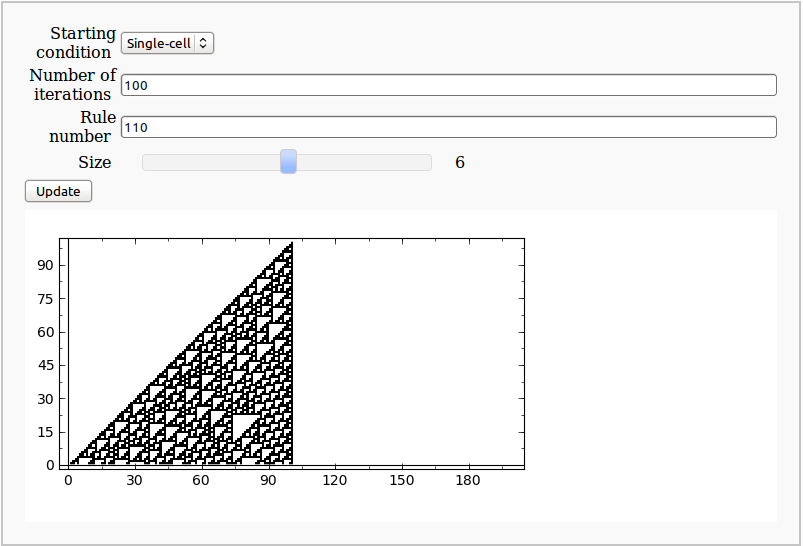
Another Interactive Venn Diagram
by Jane Long (adapted from http://wiki.sagemath.org/interact/misc)
This interact models a problem in which a certain number of people are surveyed to see if they participate in three different activities (running, biking, and swimming). Users can indicate the numbers of people in each category, from 0 to 100. Returns a graphic of a labeled Venn diagram with the number of people in each region. Returns an explanatory error message if user input is inconsistent.
